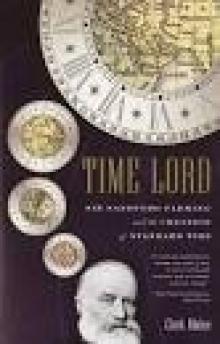Time Lord: Sir Sandford Fleming and the Creation of Standard Time 

by Clark Blaise
Genre: Other10
Published: 2000
View: 1927
Read OnlineRead Time Lord: Sir Sandford Fleming and the Creation of Standard Time Storyline:
It is difficult today to imagine life before standard time was established in 1884. In the middle of the nineteenth century, for example, there were 144 official time zones in North America alone. The confusion that ensued, especially among the burgeoning railroad companies, was an hourly comedy of errors that ultimately threatened to impede progress. The creation of standard time, with its two dozen global time zones, is one of the great inventions of the Victorian Era, yet it has been largely taken for granted.In Time Lord, Clark Blaise re-creates the life of Sanford Fleming, who struggled to convince the world to accept standard time. It’s a fascinating story of science, politics, nationalism, and the determined vision of one man who changed the world. Set in a time marked by substantial technological and cultural transformation, Time Lord is also an erudite exploration of art, literature, consciousness, and our changing relationship to timeFrom the Trade Paperback edition.Amazon.com ReviewIn the 1880s, a businessman traveling by train from New York to Boston needed, on arrival, to adjust his clock, moving it ahead by 12 minutes. The strange increment, writes Clark Blaise, was a matter of local interpretation, some enterprising Bostonian having determined that the rising sun touched the shore of Massachusetts a dozen minutes before warming Manhattan.Such local interpretations of time made the job of establishing railroad schedules a matter of guesswork and hope, as the Canadian entrepreneur Sandford Fleming discovered when he missed a train in the west of Ireland in 1876. Frustrated, Fleming realized that a new system of universal time would need to be created if railroad travel were ever to realize its full potential. As Blaise writes, "the adoption of standard time for the world was as necessary for commercial advancement as the invention of the elevator was for modern urban development," and nations such as England that had a system of standard time in place owed much of their economic superiority to the predictability and reliability such a system put in place.Fleming discovered that getting the world onto the same schedule required years of negotiating and browbeating, a nightmare that Blaise ably recounts. Fleming's efforts eventually paid off, and as Blaise writes, "Of all the inventions of the Industrial Age, standard time has endured, virtually unchanged, the longest." His entertaining account of how that came to be will be of appeal to readers who enjoyed Dava Sobel's Longitude, Henry Petroski's The Pencil, and other popular works in the history of technology. --Gregory McNameeFrom Publishers WeeklyAlthough he had consulted his guide to Irish railroad travel for the correct time of his train's departure, Sanford Fleming discovered that the train scheduled to depart at 5:35 p.m. would actually depart 12 hours later, at 5:35 a.m. Prior to 1884, conflicts like Fleming's were not unusual since time was not standardized as it is today. Determined to impose a rational order over something so elusive, Fleming, a Canadian engineer and surveyor, turned his attention to the creation of a standard global time based on a 24-hour clock, which he presented to an assemblage of leaders from around the world in 1884 at the Prime Meridian Conference in Washington, D.C. After much scrutiny and debate, these leaders accepted Fleming's proposal, agreeing that the day would begin at midnight and establishing both the Prime Meridian at Greenwich and the International Dateline. Blaise's splendid account traces Fleming's starring role as the creator of a method of measuring time that rules people's lives even today. Blaise, author of 15 previous books of both fiction and nonfiction (Brief Parables of the Twentieth Century: New and Selected Stories, etc.), presents an important history of ideas and examines how this invisible yet remarkable technological achievement of the Victorian era, a period marked by a dogged confidence in its own capacity for progress, changed the world. Blaise writes with perfect pitch and graceful narrative; his most beautiful chapter explores the ways that writers like Thomas Mann, Marcel Proust and Virginia Woolf manipulated time in their work even as they were constrained by it. (Apr. 20) Forecast: Every popular science book that comes down the pike these days is compared by its publisher to Dava Sobel's Longitude. But this beautiful little book may really follow in Sobel's footsteps. Blaise's six-city author tour (San Francisco, Minneapolis, Chicago, Iowa City, Seattle and Portland, Ore.) can only help to garner attention.Copyright 2001 Cahners Business Information, Inc.Pages of Time Lord: Sir Sandford Fleming and the Creation of Standard Time :